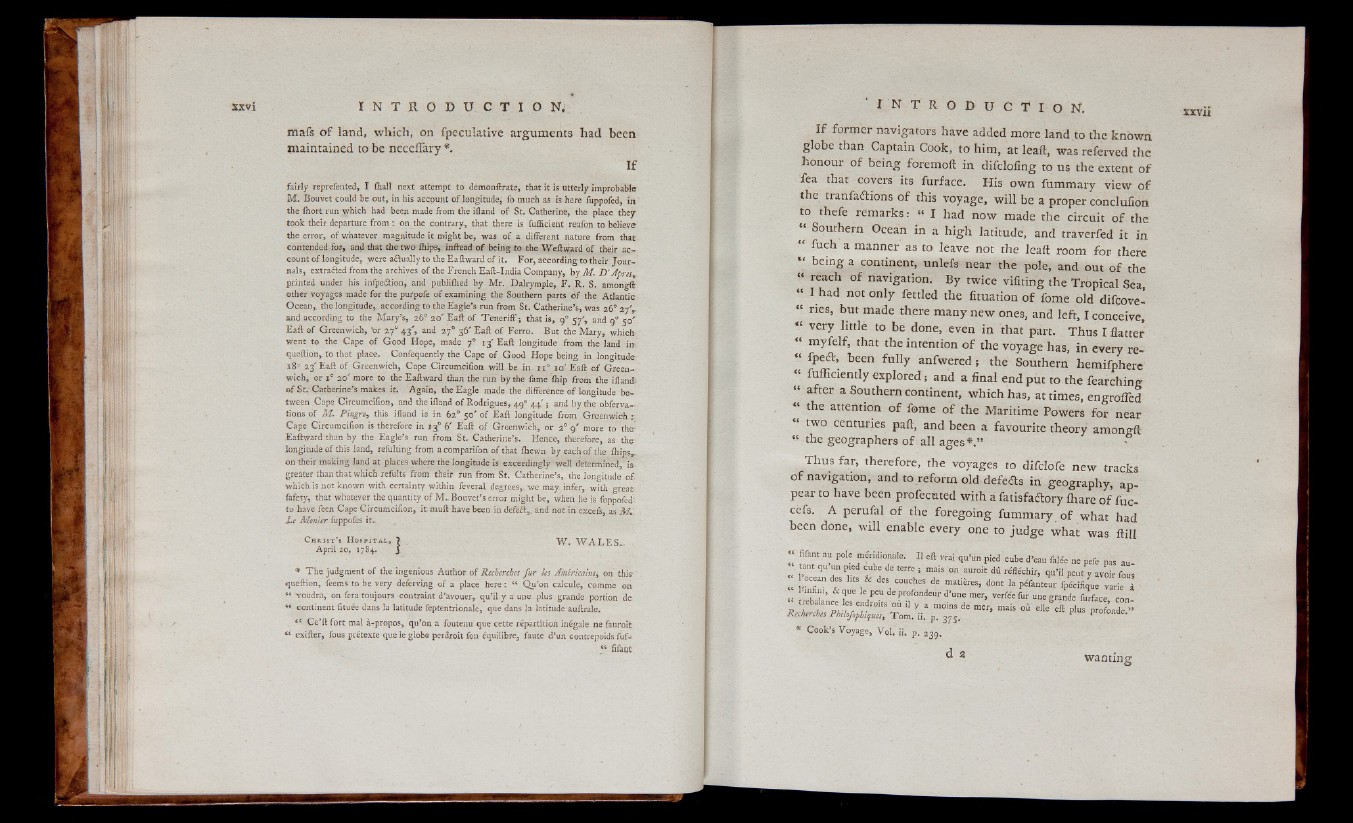
mafs of land, which, on fpeculative arguments had been
maintained to be necefiary *.
If
fairly reprefented, I Ihall next attempt to demonftrate, that it is utterly improbable
M. Bouvet could be out, in his aecpunt of longitude; fo much as is here fuppofed, in
the lhort run which had been made from the ifland o f St. Catherine, the place they
took their departure from r on the contrary, that there is fufficient reafon to believe
the error, of whatever magnitude it might be, was o f a different nature from that
contended for, and that the two ihips, inifead o f being to the Weftward o f their account
of longitude, were a&ually to the Eaftward of it. For, according to their Journals,
extracted from the archives of the French Eaft-India Company, by M . D ’ApreSy,
printed under his infpeition, and publifhed by Mr. Dalrymple, F . R. S. amongft
other voyages made for the puipofe o f examining the Southern parts o f the Atlantic
Ocean, thelongitude,. according to the Eagle’s run from St. Catherine’s, was 26° 27V
and according to the Mary’s, 26° 20' Eaft o f Teneriff; that is, 9° 57', and 9° 50'
Eaft of Greenwich, tor 27" 43', and 27° 36' Eait of Ferro. But the Mary, which
went to the Cape o f Good Hope, made 7° 13' Eaft longitude from the land in
queftion,, fo that place. Confequently the Cape o f Good Hope being in. longitude
J 8 2 3 'Eaft of Greenwich, Cape Circumcifion will be in n ° ia ' Eaft of Greenwich,
or 1° 20' more to the Eaftward than the run by the fame fh ip from the iflancb
o f St. Catherine’s makes it. Again, the Eagle made the difference o f longitude between
Cape Circumcifion, and the ifland of Rodrigues, 490 4 4 ' and by the obferva-
tions of M , P'mgrs, this ifland is in 62° 50' of Eaft longitude from, Greenwich 2
Cape Circumcifion is therefore in 1.3” 6' Eaft of Greenwich; or 2° more to the-
Eaftward than by the Eagle’s run from St.. Catherine’s. Hence, therefore, as the-
longitude of this land, refulting from a comparifon. o f that Ihewn by each of the ihips,.
on their making land at places where the longitude is exceedingly well determined," is.
greater than that which refults from their run from St. Catherine’s , the longitude of.
which-is not known with, certainty within feveral degrees, we may, infer, with great,
fafety, that whatever the quantity of M .. Bouvet’s error might be, when he is fuppofed:
to have feen Cape Circumcifion, itmuft have been, in defeil,, andnot-iri excefs,.as
Le Monier fuppofes it .
C h r i s t ’ s H o s p i t a l ,
April 20, 1784.
W . W A L E S . .
* The judgment of the ingenious Author o f Recherches fur les Américains, on this- '
queftion, feems to be very deferving of a place here : “ Qu’on calcule, comme on
46 "voudra, on fera toujours contraint dévouer, qu’il y a une plus grande portion de
continent fituée dans la latitude feptentrionale, que dans la latitude auftrale.
(t C e ’ft fort mal à-propos, qu’on a foutenu que cette répartition inégale ne fauroit
€t exifter, fous prétexte que le globe perdroit ion équilibre, faute d’un contrepoids fuf-»
u fifànt
If former navigators have added more land to the known
globe than Captain Cook, to him, at leaft, was referved the
honour o f being foremoft in difclofing to us the extent of
fea that covers its furface. His own fummary view o f
the tranfaftions o f this voyage, will be a proper conclufion
to thefe rémarks : « I had now made the circuit o f the
“ Southern Ocean in a high latitude, and traverfed it in
“ fuch a manner as to leave not the leaft room for there
«' being a continent, unlefs near the pole, and out of the
“ reach of navigation. By twice viiiting the Tropical Sea,
“ I had not only fettled the fituation o f fome old difcove-
“ ries, but made there many new ones, and left, I conceive,
« very little to be done, even in that part. Thus I flatter
myfelf, that the intention of the voyage has, in every re-
“ fpect, been fully anfwered ; the Southern hemifphere
« fufflciently explored ; and a final end put to the fearching
“ after a Southern continent, which has, at times, engrofièd
“ the attention o f fome of the Maritime Powers for near
two centuries pail, and been a favourite theory amongft
“ the geographers o f all ages
Thus far, therefore, the voyages to difclofe new tracks
o f navigation, and to reform old- defedts in geography, appear
to have been profecuted with a fatisfaclory fhare of fuc-
cefs. A perufal of the foregoing fummary of what had
been done, will enable every one to j'udge what was ftill
« fifimt au pole méridionale. II eft vrai qu’un pied cube d’eau falée ne pefe pas au
°n . fUroitdûr“ > i g f l f l y avoir fous
„ ,0Cfie“ 7 htS, & des, couches de dont la pe'fanteur fpécifique varie à
I binfim, & que le peu de profondeur d’une mer, verfée fur une grande furface con
ttebalance les endroits -ou J y a moins de mer, mais où elle eft plus profonde ”
Recherches Phihfofhtqucs, Torn. ii. p. 375. proronue.
* Cook’s Voyage, Vol. il. p. 239.
wanting